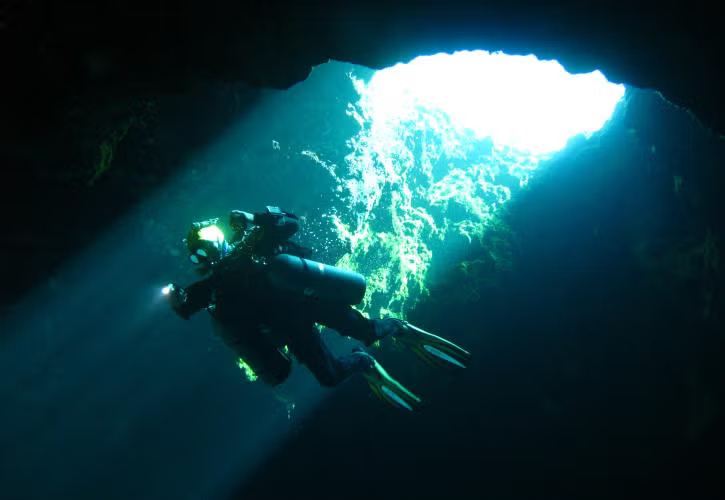- Home
- Florida History
- Florida Heritage Sites
- Wes Skiles Peacock Springs State Park
WES SKILES
PEACOCK SPRINGS STATE PARK
By Mike Miller September 26, 2025
OVERVIEW
Wes Skiles Peacock Springs State Park covers 733 acres near Live Oak, Florida. It has two major springs, a spring run, and six sinkholes.
The park protects one of the longest underwater cave systems in the continental United States. Cave divers can explore over 38,000 feet of passages.
Hikers can use the nature trails to trace the caves below. Swimmers can enjoy designated areas. Lots of visitors are drawn to its clear waters and forests.
 A cave diver at Wes Skiles Peacock Springs State Park
A cave diver at Wes Skiles Peacock Springs State ParkHISTORICAL SIGNIFICANCE
Limestone formed here millions of years ago under an ancient ocean. Native Americans used the springs for millennia.
Dr. John Calvin Peacock settled nearby in 1855. His family grew cotton and raised cattle on 1,600 acres. The springs served as a local swimming hole.
Vasco Murray made the first recorded cave dive in 1956. Sheck Exley mapped the system in 1995 after 521 dives.
A 2010 connection extended it by 10,000 feet. The Nature Conservancy bought 250 acres in 1985 to protect the caves and forests.
The state opened the park in 1993. It was renamed in 2010 for diver and photographer Wes Skiles, who died that year in a diving accident in Boynton Beach, Florida.
VISITING DETAILS
The park is at 18532 180th Street, Live Oak, FL 32060. It sits two miles east of Luraville on Peacock Springs Road, off State Road 51.
From Live Oak, drive south on SR 51 for 16 miles. The park is open daily from 8 AM to sunset.
Scuba diving requires certification proof. Swim only in Peacock Spring and Orange Grove Sink, based on water levels.
The nature trail has boardwalks and educational signs. Be aware that the dirt access road has potholes.
Pets are allowed on a 6-foot leash but not in the springs. Portable toilets are available. Call (386) 776-2194 for updates.
INTERESTING FACTS
- The cave system ranks among the world's longest, with seven major entrances.
- Five second-magnitude springs discharge 10 to 100 cubic feet of water per second.
- The Florida maple trees in the park's hardwood forest are rare for North Florida.
- Sheck Exley, a pioneer cave diver, completed the first full map in 1995.
- The 2010 dive by Australian Agnes Milowka connected Baptizing Spring to the system.
WES SKILES PEACOCK SPRINGS
STATE PARK WEBSITE
LOCATION MAP

Florida is the fastest-growing state in the United States and also the fastest-changing. If you see anything in this article that has changed or is in error, please let me know.
Thousands of Florida fans subscribe to our free daily Ezine, Florida Heritage Travel and we have 130,000 followers on Facebook.
By Mike Miller, Copyright 2009-2025
Florida-Back-Roads-Travel.com
Florida Back Roads Travel is not affiliated with or endorsed by Backroads, a California-based tour operator which arranges and conducts travel programs throughout the world.
